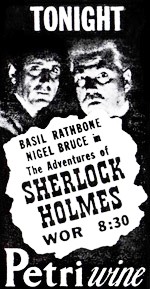
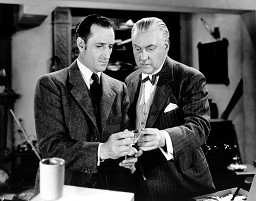 The New Adventures of Sherlock Holmes (1939-47) aired “The Copper Beeches” on October 6, 1940 as the 28th of the 220 episodes during the Rathbone/Bruce years. Our last episode of The New Adventures of Sherlock Holmes appeared in March of 2022, almost a year and a half ago, and this week’s episode is only the 6th since 2017, so I thought another one was in order. During this incarnation of Sherlock Holmes on radio (the first coming in the early 1930s and the last running to 1959), Basil Rathbone (1892-1967) and Nigel Bruce (1895-1953) reprised their Universal studio film roles of Sherlock Holmes and Dr. Watson for close to 220 episodes. Afraid of being typecast–-and following the cancellation of further Holmes films–-Rathbone wanted out of his radio role. Though the show’s sponsor at the time, Petri Wines, offered him a generous bump in compensation if he would continue, Rathbone declined. Following his final episode as Holmes at the end of May 1946, the Holmes character was played by popular British actor Tom Conway (who was an excellent Holmes), with Bruce staying on until the series end in July of 1947. For several years (from September 1945–July 1947) scripts were written by the team of future F&SF co-founder Anthony Boucher, and Denis Green. Boucher, a diehard Holmes fan, would pen the outlines of scripts and Green would supply the details. They worked well together and the show flourished.
The New Adventures of Sherlock Holmes (1939-47) aired “The Copper Beeches” on October 6, 1940 as the 28th of the 220 episodes during the Rathbone/Bruce years. Our last episode of The New Adventures of Sherlock Holmes appeared in March of 2022, almost a year and a half ago, and this week’s episode is only the 6th since 2017, so I thought another one was in order. During this incarnation of Sherlock Holmes on radio (the first coming in the early 1930s and the last running to 1959), Basil Rathbone (1892-1967) and Nigel Bruce (1895-1953) reprised their Universal studio film roles of Sherlock Holmes and Dr. Watson for close to 220 episodes. Afraid of being typecast–-and following the cancellation of further Holmes films–-Rathbone wanted out of his radio role. Though the show’s sponsor at the time, Petri Wines, offered him a generous bump in compensation if he would continue, Rathbone declined. Following his final episode as Holmes at the end of May 1946, the Holmes character was played by popular British actor Tom Conway (who was an excellent Holmes), with Bruce staying on until the series end in July of 1947. For several years (from September 1945–July 1947) scripts were written by the team of future F&SF co-founder Anthony Boucher, and Denis Green. Boucher, a diehard Holmes fan, would pen the outlines of scripts and Green would supply the details. They worked well together and the show flourished.
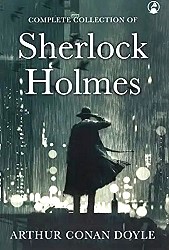 Since 130 years have passed since the first story of Sherlock Holmes and Dr. John Watson appeared in Beeton’s Christmas Annual magazine for December 1887 (A Study in Scarlet), much has been written, filmed, or dramatized of the most famous sleuth on the planet. In fact, the Wikipedia page devoted to Holmes, states that the Guinness Book of World Records’ lists the Holmes character as “the ‘most portrayed movie character in history’ with more than 70 actors playing the part in over 200 films.” And while hardly all inclusive, Wikipedia notes that those writing Holmes pastiches number the likes of Anthony Burgess, Neil Gaiman, Dorothy B. Hughes, Stephen King, Tanith Lee, A. A. Milne, and P. G. Wodehouse–to which I will add Manly Wade Wellman, Philip Jose Farmer, James Lovegrove, George Mann, Kim Newman, and Fred Saberhagen. It’s a sure bet there have been many others of genre interest over the years who have tried their hand at a Sherlock Holmes novel as well.
Since 130 years have passed since the first story of Sherlock Holmes and Dr. John Watson appeared in Beeton’s Christmas Annual magazine for December 1887 (A Study in Scarlet), much has been written, filmed, or dramatized of the most famous sleuth on the planet. In fact, the Wikipedia page devoted to Holmes, states that the Guinness Book of World Records’ lists the Holmes character as “the ‘most portrayed movie character in history’ with more than 70 actors playing the part in over 200 films.” And while hardly all inclusive, Wikipedia notes that those writing Holmes pastiches number the likes of Anthony Burgess, Neil Gaiman, Dorothy B. Hughes, Stephen King, Tanith Lee, A. A. Milne, and P. G. Wodehouse–to which I will add Manly Wade Wellman, Philip Jose Farmer, James Lovegrove, George Mann, Kim Newman, and Fred Saberhagen. It’s a sure bet there have been many others of genre interest over the years who have tried their hand at a Sherlock Holmes novel as well.
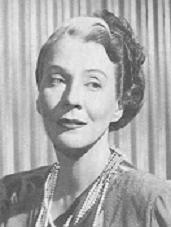 Sherlock Holmes first came to radio solely because of the tireless efforts of one remarkable woman. Edith Meiser (1898-1993) first brought Arthur Conan Doyle’s legendary sleuth to radio in 1930. She would write the scripts based on Holmes’s original adventures for the next 12 years (including this episode), sometimes branching out to pen tales in the Holmes tradition. Meiser was beloved of Sherlock Holmes fans and members of the Baker Street Irregulars (BSI), but until 1991 the BSI was a male-only organization. However, in part to rectify this situation she was welcomed into the Adventuresses of Sherlock Holmes (ASH), originally an all-female Sherlock Holmes club, though it would later open its doors and become co-ed. The day every year that the BSI would hold its annual dinner, so too would the ASH, with Edith Meiser as its Guest of Honor. During the 1950s Meiser also wrote a daily Holmes comic strip, and was considered a great Broadway actress who also starred in films and early television, including appearances on I Love Lucy. One of the great unsung heroines of early radio (to the outside world at least), she died in 1993.
Sherlock Holmes first came to radio solely because of the tireless efforts of one remarkable woman. Edith Meiser (1898-1993) first brought Arthur Conan Doyle’s legendary sleuth to radio in 1930. She would write the scripts based on Holmes’s original adventures for the next 12 years (including this episode), sometimes branching out to pen tales in the Holmes tradition. Meiser was beloved of Sherlock Holmes fans and members of the Baker Street Irregulars (BSI), but until 1991 the BSI was a male-only organization. However, in part to rectify this situation she was welcomed into the Adventuresses of Sherlock Holmes (ASH), originally an all-female Sherlock Holmes club, though it would later open its doors and become co-ed. The day every year that the BSI would hold its annual dinner, so too would the ASH, with Edith Meiser as its Guest of Honor. During the 1950s Meiser also wrote a daily Holmes comic strip, and was considered a great Broadway actress who also starred in films and early television, including appearances on I Love Lucy. One of the great unsung heroines of early radio (to the outside world at least), she died in 1993.
In this episode it is revealed early on that Holmes has been eavesdropping on Watson as he tells of his and Holmes’ adventures. Holmes criticizes Watson for emphasizing the sentimental aspects in his recountings over the logical aspects, believing that reader interest is best held by clever deduction rather than the unoriginal and uninspired class of criminals that abound at the present time. Thus, with no first class criminals with which to compete, it is the duty of the raconteur to emphasize the more fascinating elements of the chase and capture, those being, of course, the wit and ratiocinative powers of Sherlock Holmes. Does Holmes’ observation about how to maintain reader interest in Watson’s stories hold true in this current adventure? Is the evil doer on an intellectual par with Holmes this time around, as he tries to solve the case given the name of “The Copper Beeches”? Listen now to this cleverly conceived tale and judge for yourself.
Play Time: 29:35
{Airing on a Sunday evening in the fall of 1940, the neighborhood gang could hardly wait for school to let out the next afternoon so they could hightail it to the nearby newsstand. Illustrated pulp magazines and the stories they told were much more to their liking than what they had to suffer through in their classroom each day. Astonishing Stories (1940-43) was published on a shoestring and lasted but 16 issues, but it nevertheless managed to acquire stories from some of the brightest, upcoming stars in the field, along with familiar stalwarts from the beginnings of the SF magazines like those given cover space below: Malcolm Jameson, Ray Cummings, and Harl Vincent, all seasoned veterans whose pounded out stories not only filled the pages of the early SF magazines but the imaginations of the youngsters reading them. I still chuckle each time I read the title of the Jameson cover story: “Quicksands of Youthwardness.” What exactly, you may ask, is “youthwardness” and what kind of strange tale does Jameson weave around this awkwardly humorous made up word? Astonishing was a bi-monthly in 1940, the first and last year it would publish with that schedule. Astounding SF (1930-present, now Analog) was now, by 1940, firmly in the hands of its future legendary editor, John W. Campbell, Jr., and for the first years of Campbell’s editorial directorship he would be discovering at least one major new talent in each issue. This issue featured the second of four installments of what would become one of A. E. van Vogt’s classic novels, Harry Bates’ memorable novelette “Farewell to the Master,” the story upon which the 1951 film The Day the Earth Stood Still was based, stories by Theodore Sturgeon, L. Sprague de Camp, and several others including the previously mentioned Malcolm Jameson. A collectors’ issue for sure. ASF was a monthly in 1940. Weird Tales (1923-54) was the ultimate supernatural watering hole for the scariest and ultimately most terrifying stories imaginable. One never knew just where its evil would reside or what form it would take, but youngsters of all ages kept their nickels and dimes coming regularly, as humble offerings to the hooded figure behind the store counter who kept them enthralled with each issue of “the unique magazine” he brought forth for sale. WT was a bi-monthly in 1940.}
[Left: Astonishing, Oct. 1940 – Center: Astounding SF, Oct. 1940 – Right: Weird Tales, Sept. 1940]
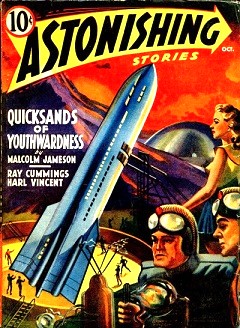

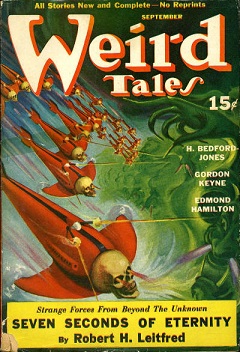
To view the entire list of weekly Old Time Radio episodes at Tangent Online, click here.